Recently updated on January 8th, 2026 at 08:45 am
Staying active and healthy is crucial for seniors to maintain their overall well-being and quality of life. Regular physical activity helps improve balance, flexibility, and strength, reducing the risk of falls and injuries. It also enhances cardiovascular health, boosts mood, and promotes better sleep, all essential for healthy aging.
Home workouts for seniors are not just convenient; they are also safe. They allow you to exercise in the comfort of your own home, eliminating barriers such as transportation issues or concerns about weather conditions. This makes it easier to stick to a consistent exercise routine tailored to your individual needs and preferences.
In 2025, senior fitness is increasingly driven by technology, with wearable devices and AI-powered apps offering personalized plans and real-time feedback. Remote personal training and virtual group classes also enhance accessibility, while a focus on functional strength training and holistic wellness integrates mental health and social connections for better outcomes.
Here Are the Seven Best Home Workouts for Seniors to Stay Active and Healthy:
- Chair Exercises:
Incorporating seated exercises using a sturdy chair can help improve strength, flexibility, and balance, with structured programs shown to reduce fall risk by up to 30%.
- Walking:
Walking is a low-impact aerobic exercise that can be done quickly indoors or outdoors. The walk at home workout for beginners and seniors, for both it’s important. It improves cardiovascular health and strengthens muscles without straining the joints.
- Yoga:
Gentle yoga poses and stretches can enhance flexibility, improve posture, and promote relaxation. Even everyday 10 minutes home workout for seniors can do miracle. Yoga also helps reduce stress and anxiety, benefiting physical and mental well-being.
- Tai Chi:
This ancient Chinese martial art focuses on slow, flowing movements and deep breathing. Tai Chi enhances balance, coordination, and strength while fostering a sense of calm and inner peace.
- Resistance Band Workouts:
Resistance bands are lightweight and versatile tools for strengthening muscles and improving range of motion, with studies showing they can increase muscular strength by up to 40% in seniors and promote bone health.
- Water Aerobics:
Water exercises offer buoyancy and resistance, making them gentle on the joints while providing a full-body workout. For added convenience, water aerobics classes or routines can be done in a pool or even a bathtub.
- Dance:
Dancing is a fun way to stay active while improving cardiovascular health, coordination, and mood. Seniors can dance to their favourite music in the comfort of their home, alone or with a partner.
By incorporating these home workouts for seniors into their daily routine, older adults can maintain their physical and mental health, stay independent, and enjoy a higher quality of life as they age. This sense of accomplishment and satisfaction is a significant benefit of home workouts.
Emerging trends highlight the importance of community-driven and evidence-based approaches, such as chair yoga and resistance band programs, which have been shown to improve flexibility, reduce joint pain, and significantly boost strength and fall prevention in group settings.
Why Home Workouts Are Beneficial for Seniors
Senior home care and workouts offer many benefits, catering specifically to their unique needs and preferences. Safety is paramount, particularly for older adults, and exercising in a familiar home environment reduces the risk of accidents or injuries. The senior lifestyle services are also even provided for the same reasons. Additionally, the convenience of home workouts eliminates barriers like transportation issues or concerns about weather conditions, making it easier to maintain a consistent exercise routine.
Customization is a key advantage at home workouts for seniors. This allows individuals to tailor their exercises to their fitness levels and physical abilities, ensuring a safe and effective workout regimen. This personalized approach empowers seniors to progress at their own pace, minimizing the risk of overexertion or strain.
Furthermore, home workouts offer flexibility in terms of scheduling and variety. Depending on their preferences and mobility levels, seniors can choose from various exercises, including chair exercises, resistance band workouts, or yoga. This variety keeps workouts engaging and enjoyable, targets different muscle groups, and promotes overall fitness and well-being.
Overall, home workouts provide seniors with a safe, convenient, and effective means of staying active and healthy, empowering them to maintain their independence and quality of life as they age.
Essential Tips Before Starting Home Workouts
Before embarking on a home workout routine, seniors must take certain precautions to ensure their safety and maximize the effectiveness of their exercises.
First and foremost, consult with a healthcare professional, such as a doctor or physical therapist. They can provide valuable guidance on which exercises are safe and appropriate based on individual health conditions and medical histories.
Additionally, having the right equipment is essential for a successful home workout.
Depending on the chosen exercises, this may include items such as comfortable workout attire, supportive footwear, resistance bands, yoga mats, or even household items like water bottles and cans for resistance training.
Creating a designated workout space within the home is also essential. This area should be clear of obstacles and hazards, with sufficient lighting and ventilation. Seniors should ensure that the floor is non-slippery and that any furniture or equipment is stable and secure.
When starting a new workout routine, it’s advisable to begin gradually and listen to one’s body. Seniors should pay attention to any discomfort or pain and adjust the intensity or duration of exercises accordingly. It’s normal to experience some muscle soreness, but persistent or severe pain may indicate the need to modify or discontinue certain activities.
By following these essential tips, seniors can prepare themselves for safe and effective home workouts, promoting their overall health and well-being for years to come.
Chair Yoga
Chair yoga is a modified form that utilizes a chair for support, making it accessible for seniors of all fitness levels. Here’s a simple chair yoga routine to improve flexibility and relaxation:
Steps:
- Sit comfortably in a sturdy chair with your feet flat on the floor and your spine tall.
- Begin with deep, slow breaths, inhaling through your nose and exhaling through your mouth.
- Neck Stretch: Tilt your head to one side, bringing your ear towards your shoulder. Hold for a few breaths, then switch sides.
- Shoulder Rolls: Roll your shoulders forward and backward in a smooth, circular motion, releasing tension in the neck and shoulders.
- Seated Cat-Cow: Inhale as you arch your back and look up, then exhale as you round your spine and tuck your chin towards your chest.
- Seated Forward Fold: Slowly hinge from your hips, reaching your hands towards your feet or the floor. Hold for a few breaths, then slowly return to an upright position.
- Seated Twist: Place one hand on the opposite knee and the other on the back of the chair. Twist gently towards the back of the chair, keeping your spine tall.
- End with a few more deep breaths, focusing on relaxation and releasing tension.
Benefits: Chair yoga helps improve flexibility, mobility, and circulation while reducing stiffness and joint pain. It is also helpful for the managing of exercises for Lower Back Pain for Seniors. It also promotes relaxation and reduces stress, benefiting physical and mental well-being.
Modifications: Seniors can modify chair yoga poses using props such as cushions or blocks for additional support. They can also adjust the range of motion based on their comfort level, avoiding any movements that cause pain or discomfort.
Gentle Stretching
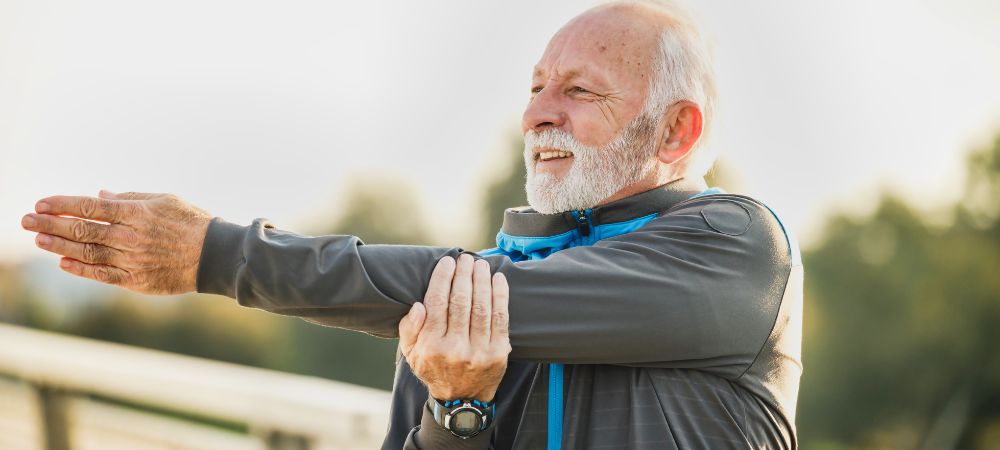
Gentle stretching is essential for maintaining mobility and preventing muscle stiffness in seniors. Here’s a simple stretching routine to improve flexibility:
Steps:
- Start by standing or sitting comfortably with your feet hip-width apart.
- Neck Stretch: Tilt your head to one side, bringing your ear towards your shoulder. Hold for 10-15 seconds, then switch sides.
- Shoulder Stretch: Bring one arm across your body and gently press it towards your chest with the opposite hand. Hold for 10-15 seconds, then switch sides.
- Triceps Stretch: Reach one arm overhead and bend your elbow, placing your hand between your shoulder blades. Use the opposite hand to gently press on the elbow, feeling a stretch along the back of the arm. Hold for 10-15 seconds, then switch sides.
- Hamstring Stretch: Sit on the edge of a chair and extend one leg straight in front of you, with your heel on the floor and toes pointing towards the ceiling. Lean forward slightly from your hips, feeling a stretch along the back of the extended leg. Hold for 10-15 seconds, then switch legs.
- Calf Stretch: Stand facing a wall and place both hands on the wall at shoulder height. Step one foot back, keeping it straight with the heel on the floor. Lean forward slightly, feeling a stretch in the calf of the back leg. Hold for 10-15 seconds, then switch sides.
- Finish with deep breaths, inhaling deeply through your nose and exhaling slowly through your mouth.
Benefits: Gentle stretching improves flexibility, range of motion, and circulation, reducing the risk of injury and enhancing overall mobility. It also helps alleviate muscle tension and promotes relaxation, improving physical and mental well-being.
Modifications: Seniors can modify stretches by adjusting the intensity or duration to suit their needs and abilities. They can also use props such as straps or towels to assist with stretching, making it easier to reach or hold positions comfortably.
Walking at Home
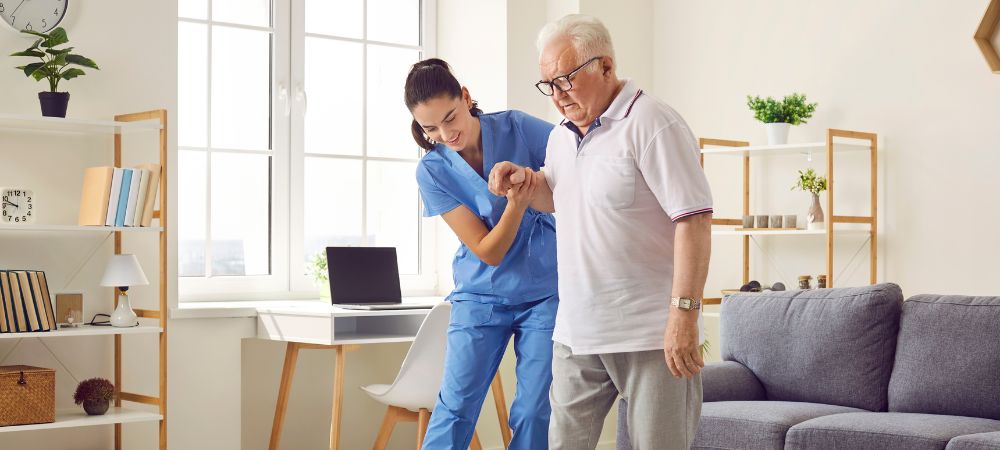
Walking is a simple yet effective exercise that can be quickly done at home, providing numerous health benefits for seniors. Here’s a beginner-friendly walk at home workout:
Steps:
- Start by warming up with minutes of marching in place or walking around the house comfortably.
- Set a goal for your walk, whether a certain distance or duration and gradually increase it over time.
- Use a pedometer or fitness tracker to monitor your steps and progress. This will motivate you to stay active and reach your goals.
- Incorporate brisk walking or marching intervals to increase your workout’s intensity and boost cardiovascular health.
- Pay attention to your posture and stride, keeping your spine tall and shoulders relaxed. Engage your core muscles for stability and balance.
- Cool down slowly with a few minutes of walking, then gently stretching for the legs, hips, and lower back.
Benefits: Walking at home improves cardiovascular health, strengthens muscles, and supports bone density, reducing the risk of chronic conditions such as heart disease, diabetes, and osteoporosis. It enhances mood, reduces stress, and promotes mental clarity and well-being.
Modifications: Seniors can modify the intensity and duration of their walks based on their fitness level and comfort. They can also vary the terrain by walking on different surfaces such as carpet or hardwood floors or outdoors in the yard or neighborhood. Walking aids such as a cane or walker can provide additional support and stability if needed.
Resistance Band Exercises
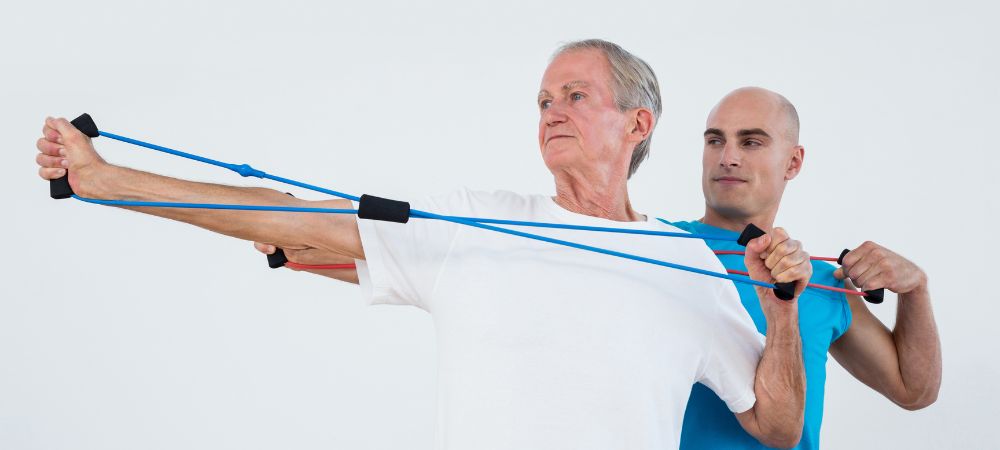
Resistance band exercises are convenient and effective for seniors to improve strength and flexibility without heavy weights or equipment. Here are some simple resistance band exercises to try:
Steps:
- Bicep Curls: Stand with feet hip-width apart and hold the resistance band with palms facing up. Keep elbows close to your sides as you bend your arms, bringing your hands towards your shoulders. Slowly lower back down and repeat for 10-15 repetitions.
- Shoulder Press: Sit or stand with feet shoulder-width apart and hold the resistance band at shoulder height, palms facing forward. Press arms overhead until fully extended, then lower back down with control. Repeat for 10-15 repetitions.
- Seated Row: Sit on a chair with legs extended and loop the resistance band around your feet. Hold one end of the band in each hand, palms facing each other. Pull elbows back, squeezing shoulder blades together, then slowly release. Repeat for 10-15 repetitions.
- Leg Press: Sit on a chair with one end of the resistance band looped around your foot and the other secured under the opposite foot. Extend the banded leg straight before you, pressing against the band’s resistance. Slowly bend and straighten the leg for 10-15 repetitions, then switch sides.
- Chest Press: Secure the resistance band around a sturdy object at chest height and stand away from it. Hold one band end in each hand; elbows bent at 90 degrees. Press your arms forward until fully extended, then slowly release them back to the starting position. Repeat for 10-15 repetitions.
Benefits: Resistance band exercises improve muscle strength, endurance, and flexibility, targeting major muscle groups. They also help maintain bone density and support joint health, reducing the risk of osteoporosis and arthritis.
Modifications: Seniors can modify resistance band exercises by adjusting the band’s tension to suit their strength level. They can use lighter resistance bands or increase/decrease the length of the band to make exercises more accessible or more challenging. Additionally, exercises can be performed seated or standing, depending on mobility and stability.
Seated Marches
Seated marches are a simple yet effective cardiovascular exercise that can be done at home to improve heart health and circulation. Here’s how to perform seated marches:
Steps:
- Sit comfortably in a sturdy chair with your feet flat on the floor and your spine tall.
- Begin by marching in place, lifting one knee towards your chest and then the other, alternating legs.
- Pump your arms back and forth in rhythm with your leg movements, engaging your core muscles for stability.
- Continue marching for 1-2 minutes, gradually increasing the pace to elevate your heart rate and intensity.
- Focus on maintaining proper posture and breathing deeply throughout the exercise, inhaling through your nose and exhaling through your mouth.
Benefits: Seated marches help improve cardiovascular health and circulation, and when part of a structured program, they can reduce fall risk by up to 30%.
They also strengthen leg muscles and support balance and coordination.
Modifications: Seniors can modify seated marches by adjusting the speed and intensity of the movements to suit their fitness level and comfort. They can also incorporate variations such as marching with high knees or adding arm movements for additional challenges. Seniors can perform seated marches with assistance from a sturdy object for balance and support if needed.
Light Weight Lifting
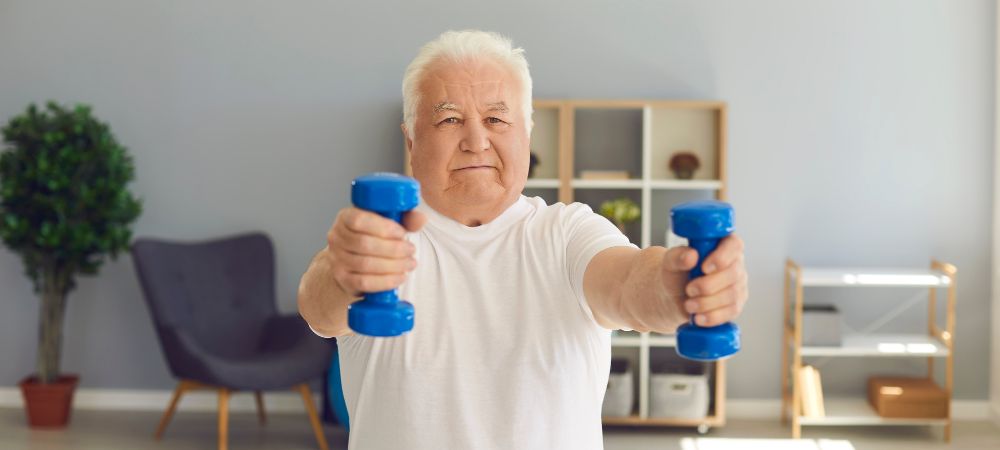
Light weight lifting is a safe and effective way for seniors to build muscle strength and bone density, using either light weights or household items as resistance. Here are some simple exercises to try:
Steps:
- Bicep Curls: Hold light weights or household items such as water bottles in each hand, palms facing up. Keep elbows close to your sides as you bend your arms, bringing your hands towards your shoulders. Slowly lower back down and repeat for 10-15 repetitions.
- Shoulder Raises: Hold weights or household items in each hand, with your arms by your sides. Raise arms to the sides until parallel to the floor, then slowly lower back down. Repeat for 10-15 repetitions.
- Tricep Extensions: Hold a weight or household item in one hand and raise it overhead, keeping your elbow close to your ear. Bend your elbow, lowering the weight behind your head, then straighten your arm back up. Repeat for 10-15 repetitions, then switch arms.
- Leg Lifts: Stand behind a sturdy chair and hold onto the back for support. Lift one leg straight to the side, keeping it straight and engaging your outer thigh muscles. Slowly lower back down and repeat for 10-15 repetitions, then switch legs.
- Squats: Stand with feet hip-width apart and hold weights or household items at your sides. Bend your knees and lower into a squat, keeping your chest lifted and knees behind your toes. Press through your heels to stand back up, squeezing your glutes at the top. Repeat for 10-15 repetitions.
Benefits: Light weight lifting helps improve muscle strength, endurance, and bone density, reducing the risk of osteoporosis and age-related muscle loss. It also supports joint health and stability, promoting better balance and mobility in daily activities.
Modifications: Seniors can modify lightweight lifting exercises using lighter weights or household items such as cans of soup or water bottles to reduce resistance. Depending on mobility and stability, they can also perform exercises seated or standing. It’s essential to start with light resistance and gradually increase as strength improves, avoiding any exercises that cause pain or discomfort.
Minute Full-Body Workout
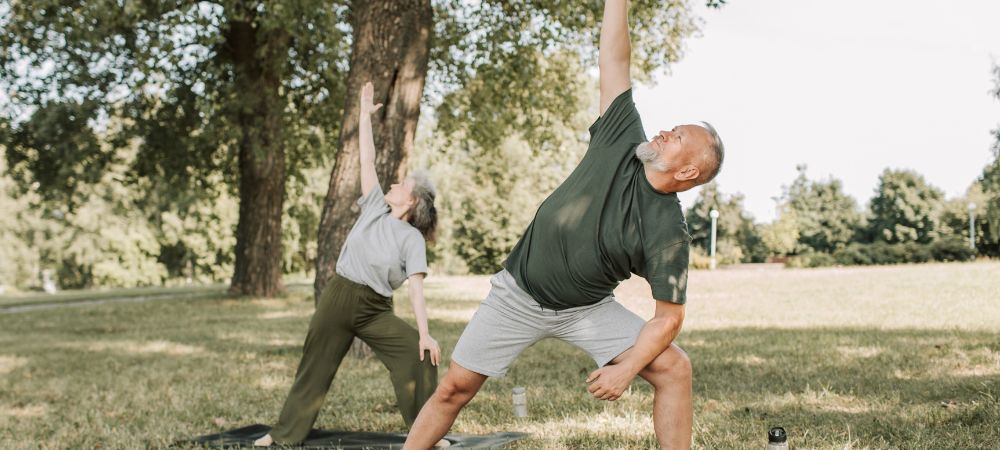
This quick and efficient 10-minute full-body workout is gaining traction for its accessibility and high adherence, proven to improve mobility, mood, and independence when integrated daily.
Steps:
- Warm-Up: Start with 1-2 minutes of marching in place or walking around the house to get your heart rate up and prepare your muscles for exercise.
- Chair Squats: Stand in front of a sturdy chair with feet hip-width apart. Bend your knees and lower into a squat, tapping your glutes lightly on the chair before standing back up. Repeat for 10-15 repetitions.
- Wall Push-Ups: Stand facing a wall with arms extended at shoulder height, palms flat against the wall. Lower your chest towards the wall, keeping elbows close to your sides, then push back up to the starting position. Repeat for 10-15 repetitions.
- Seated Leg Lifts: Sit on the edge of a chair with feet flat on the floor. Lift one leg before you, engaging your core muscles and keeping your back straight. Lower leg back down with control and repeat on the other side. Continue alternating legs for 10-15 repetitions.
- Standing Leg Curl: Stand behind a sturdy chair and hold onto the back for support. Bend one knee and bring your heel towards your glutes, engaging hamstring muscles. Slowly lower your leg back down and repeat on the other side. Continue alternating legs for 10-15 repetitions.
- Arm Circles: Stand with feet hip-width apart and arms extended to the sides at shoulder height. Make small circles with your arms, gradually increasing the size of the circles. After 10-15 seconds, reverse direction. Repeat for 1 minute.
- Cool Down: Finish with 1-2 minutes of walking in place or gentle stretching for the legs, arms, and back to relax and restore.
Benefits: This 10-minute full-body workout targets major muscle groups, including legs, arms, chest, and core, providing a comprehensive and time-efficient way to improve strength and flexibility. It also boosts cardiovascular health and increases energy levels, invigorating and revitalizing seniors.
Modifications: Seniors can modify the intensity and duration of exercises based on their fitness level and comfort. Depending on mobility and stability, they can also perform exercises seated or standing. It’s essential to listen to your body and avoid any movements that cause pain or discomfort, making adjustments to ensure a safe and effective workout.
Safety Tips and Precautions
When engaging in home workouts, it’s essential to prioritize safety to ensure a positive and practical exercise experience. Here are some safety tips and precautions for seniors:
- Warm-Up and Cool-Down: Always start your workout with a gentle warm-up to prepare your muscles and cardiovascular system for exercise. Similarly, conclude your workout with a cool-down to gradually lower your heart rate and promote muscle relaxation.
- Monitor Heart Rate: Monitor your heart rate during exercise to ensure you’re working at a safe intensity. Aim for a moderate level of exertion where you can still comfortably carry on a conversation. If you experience chest pain, dizziness, or shortness of breath, stop exercising immediately and seek medical attention.
- Avoid Overexertion: Listen to your body and avoid pushing yourself too hard, especially if you’re starting or recovering from an injury. Take breaks as needed, and don’t hesitate to modify or scale back exercises if they feel too challenging.
- Stay Hydrated: Drink plenty of water before, during, and after workouts to prevent dehydration and maintain optimal performance. Seniors may be more prone to dehydration, so it’s essential to replenish fluids regularly.
Conclusion
Staying active through home workouts offers numerous benefits for seniors, including improved physical health, enhanced mood, and increased independence. By starting with simple and accessible exercises, seniors can gradually build strength, flexibility, and endurance while reducing the risk of injury and chronic disease.
You should incorporate these senior home workouts into your daily routine and discover the joy and satisfaction of staying active at home. Remember, consistency is vital, so make exercise a regular part of your lifestyle and enjoy the long-term benefits it brings.
Home workouts for seniors offer unparalleled convenience and adaptability. They allow you to exercise on your own terms and in the comfort of your own home. Whether you’re a beginner or a seasoned fitness enthusiast, there’s a workout routine that’s right for you. Even everyday 10 minutes home workout for the seniors is the best.
I invite you to share your favourite home workouts or experiences in the comments below. Your insights and tips may inspire others on their fitness journey, creating a supportive and encouraging community of like-minded individuals committed to healthy aging.
Let’s embark on this journey together and embrace the power of home workouts to transform our lives. Here’s to a happier, healthier, and more active future ahead!
“Transform your loved one’s life with our personalized in-home care services. Book a consultation now and discover the difference with Loving Home Care!”
FAQs
- Is it safe for seniors to do home workouts? Yes, senior home workouts can be safe for seniors when done correctly. Seniors must consult with their healthcare provider before starting any new exercise routine to ensure it’s appropriate for their health needs and conditions.
- What equipment do I need for home workouts? The necessary equipment at home workouts for seniors can vary depending on the exercises being performed. Standard equipment includes a sturdy chair, resistance bands, light weights or household items, and a yoga mat or towel for cushioning.
- How often should seniors do home workouts? Seniors should aim to incorporate physical activity into their daily routine, aiming for at least 150 minutes of moderate-intensity aerobic activity per week and muscle-strengthening activities on two or more days per week. However, starting slowly and gradually increasing the duration and intensity of workouts is essential to avoid injury.
- What are the benefits of home workouts for seniors? Home workouts offer numerous benefits for seniors, including improved cardiovascular health, muscle strength, flexibility, balance, and mood. They also provide a convenient and accessible way for seniors to stay active and maintain their well-being.
- Can I modify my home workouts to fit my fitness level? Home workouts can be easily modified to accommodate individual fitness levels and abilities. Seniors can adjust exercises’ intensity, duration, and complexity to suit their needs, gradually increasing as strength and confidence improve.
- Are there specific precautions I should take before starting home workouts? Before beginning any new exercise routine, seniors should consult with their healthcare provider to ensure it’s safe and appropriate for their health needs. It’s also essential to warm up before exercising, stay hydrated, and listen to your body, avoiding any movements that cause pain or discomfort.
- How can I stay motivated to do home workouts? Staying motivated to exercise at home can be challenging, but setting realistic goals, varying your routine, and finding activities you enjoy can help keep you engaged and motivated. It can also be helpful to enlist the support of friends or family members or join online fitness communities for encouragement and accountability.
- What should I do if I experience pain or discomfort during a home workout? If you experience pain or discomfort during a home workout, stop exercising immediately and rest. It’s essential to listen to your body and avoid pushing through pain, as this can lead to injury. If pain persists, consult your healthcare provider for further evaluation and guidance.

